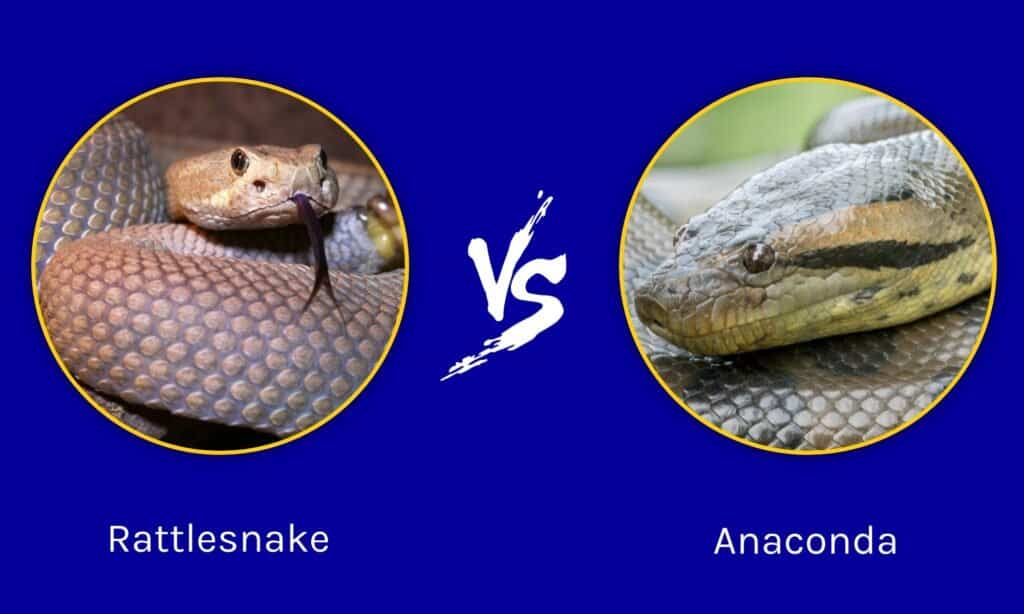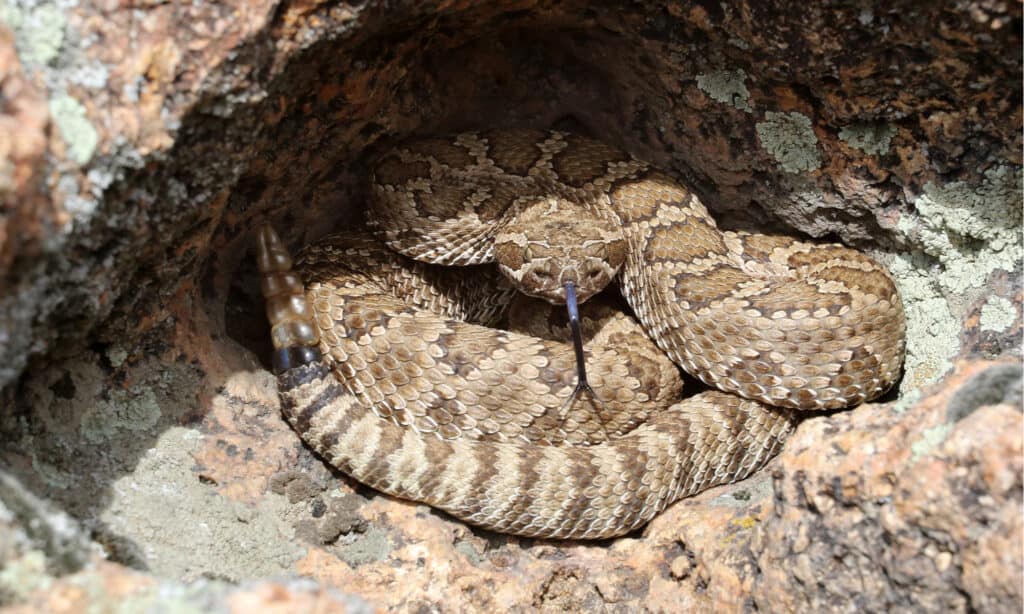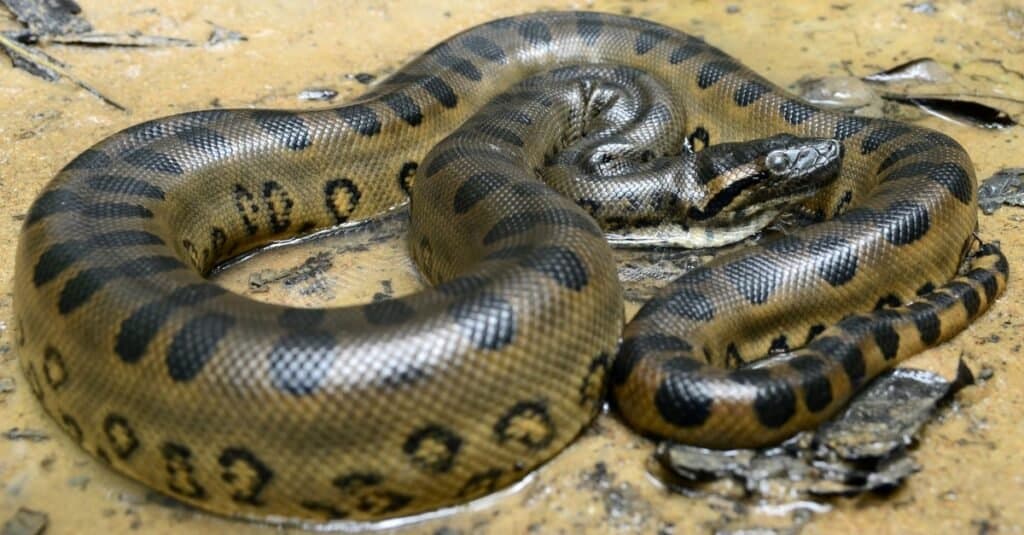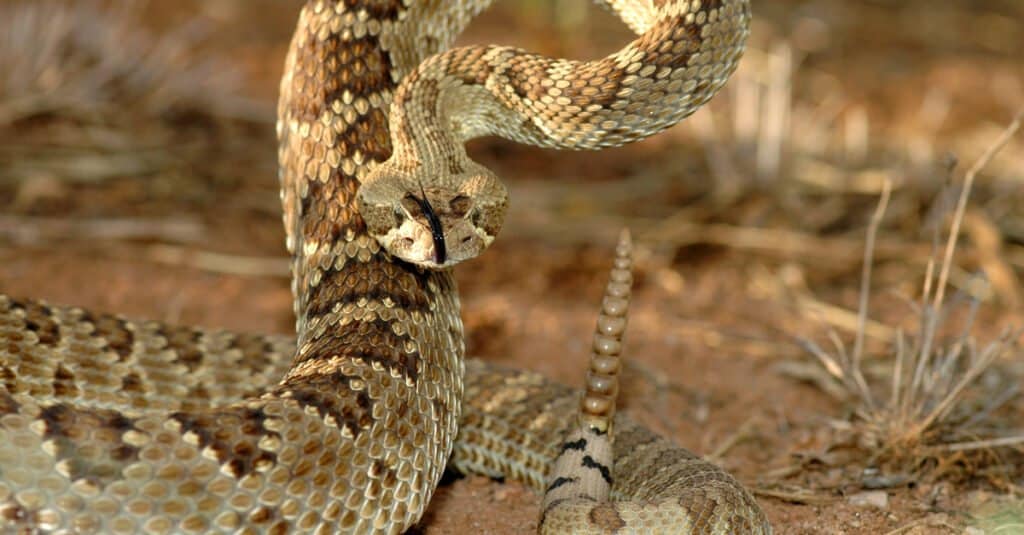Rattlesnakes are the largest venomous snakes in the United States. The anaconda is a non-venomous constrictor that suffocates by coiling its heavy body tightly around prey. And its body is truly heavy- anacondas are the heaviest snakes in the world. Rattlesnakes and anacondas are snakes of legend, inspiring fear, and awe in the minds of humans throughout history. Let’s look at rattlesnake vs anaconda and see how these legendary snakes differ.
Rattlesnake Vs Anaconda Comparison

| Rattlesnake | Anaconda | |
|---|---|---|
| Scientific Classification | Family: Viperidae; Genus: Crotalus, Sistrurus | Family: Boidae Genus: Eunectes |
| Range & Habitat | The Americas; primarily terrestrial; desert, rocky hills, swamplands, meadows | South America; primarily aquatic; swamps, slow-moving rivers, and dense rainforests |
| Size | Average 1.5-6.5 ft long, up to 8 ft; up to 10 lbs, males slightly larger | Average 9-16 feet long, up to 20 ft; 65-155 lbs, can be over 200 lbs, females much larger |
| Features | Pit organs, tail rattles, keeled scales | Eyes & nose on top of the head, two lungs, smooth scales |
| Hunting | Ambush predators, kill by injecting venom with fangs | Ambush predator, kill by constriction |
| Prey | Rodents, birds, rabbits, small frogs & lizards | Fish, birds, mammals, other reptiles. Sometimes deer, tapir, caiman, capybara, crocodiles, and jaguars. |
| Danger to Humans | High risk of exposure, bites require medical attention | low risk of exposure, attacks on humans exceptionally rare |
Key Differences between a Rattlesnake and an Anaconda

The size of the Anaconda is a major difference.
©iStock.com/Schumaher
The key differences between a Rattlesnake and an Anaconda are classification, size, habitat, range and appearance. They both possess venom, but one has a higher risk of exposure to humans than others.
The differences are explained below.
Rattlesnake Vs Anaconda: Scientific Classification
Rattlesnakes are venomous, fanged pit vipers of the family Viperidae. They derive their family name Viperidae from the latin vivus, “alive” and parere, “to bear.” This refers to their method of bearing live young, as do the anacondas. As pit vipers, they belong to the subfamily Crotalinae. The members of this subfamily are distinguished by their heat-sensing pit organs. There are over 30 rattlesnake species, and most fall into the genus of Crotalus. This genus name is derived from the word for “castanet.” There are a couple of rattlesnakes in the genus Sistrurus, meaning “tail rattler.” This name shares its root with the sistrum, a type of ancient Egyptian musical rattle.
Anacondas, also known as water boas, are of the family Boidae. This is a group of nonvenomous constrictor snakes commonly known as boas. Anacondas are of the genus Eunectes which includes four species of snakes. The genus name is derived from the ancient Greek word for “good swimmer.” Although the name anaconda refers to the genus, it’s often used to refer to the green anaconda. Also known as the common anaconda or giant anaconda, the green anaconda species name is Eunectes murinus. The word murinus means “of mice,” as these constrictors were initially believed to prey mostly on mice.
Four anaconda species:
- Bolivian anaconda, Eunectes beniensis
- Dark-spotted anaconda, Eunectes deschauenseei
- Green anaconda, Eunectes murinus
- Yellow anaconda, Eunectes notaeus
Rattlesnake Vs Anaconda: Range & Habitat

Rattlesnake is native to the Americas.
©Randy Bjorklund/Shutterstock.com
Rattlesnakes are native to the Americas, from southern Canada to Argentina. The highest concentration of rattlesnakes lives in the southwestern United States and northern parts of Mexico. Arizona is home to the most rattlesnake species, with 13 species living there. Many rattlesnakes live in the dry desert climate of the southwest United States, but they may thrive elsewhere. These snakes do well in grassy or brushy areas, rocky hills, swampland, and meadows. They live as high as 11,000 feet above sea level. Rattlesnakes make their home within rocky crevices. They live communally in these dens during a period of rest in the cold winter months, called brumation.
Anacondas are endemic to South America. They live primarily in the Amazon and the Orinoco River Basins, but also as far north as Trinidad and south of Paraguay. They live in swamps, slow-moving rivers, dense forests of Bolivia, Brazil, Ecuador, Paraguay, Columbia, Venezuela, Trinidad, and the Guianas. Anacondas thrive in the high heat and humidity of the dense rainforest and are at home in the water, but they can be found in the drier areas of meadows. The green anaconda is especially fond of flooded grasslands. They prefer solitary living and brumate during the dry season by burying themselves in the mud.
Rattlesnake Vs Anaconda: Appearance

Anacondas can weigh more than 200 pounds.
©Patrick K. Campbell/Shutterstock.com
Anacondas are 9 to 16 feet long and 65 to 155 pounds, on average. They exhibit sexual dimorphism, with females reaching much greater sizes than males. Males get up to 14 feet in length, while female anacondas can reach 20 feet and weigh more than 200 pounds. Anacondas are the heaviest snakes in the world. They have thick necks but somewhat narrow heads in comparison to their bodies. Eyes set on top of their head allow them to skim the surface of the water as they hunt. These snakes tend to be olive green with darker spots making intricate patterns that run the length of their bodies. A yellowish-brown stripe often runs the length of their bodies. Their smooth scales grow larger further down the length of them. In contrast to most snakes, anacondas have two lungs. They also have tiny, vestigial hip and back leg bones hidden within their bodies.
Rattlesnakes vary significantly in size by species but are generally 1.5 to 6.5 feet in length. Some, like the eastern diamondback, can grow up to 8 feet in length and weigh up to 10 pounds. They exhibit sexual dimorphism, with males typically growing slightly larger than females. They have thick bodies with heavily-ridged, “keeled” scales. Coloration varies, but they typically have dark diamond patterns or other geometric shapes on a lighter body. Their distinctive tail rattles are made of hollow keratin chambers. These knock together to produce sound. These snakes have triangular heads and hinged fangs. Rattlesnakes have pit organs beside their nose and eyes, which detect the heat signatures of warm-blooded animals nearby like an infrared camera.
Rattlesnake Vs Anaconda: Hunting & Diet
Rattlesnakes use their heat-sensing pit organs, along with their keen sense of sight and smell to locate prey. They are ambush predators that lie in wait for unsuspecting prey to pass by. When they do, rattlesnakes strike out quickly and sink their fangs to deliver venom. The venom immobilizes their prey, which includes rodents, birds, rabbits, and small creatures like frogs and lizards. They typically don’t need more than one meal every few weeks in adulthood.
Anacondas are primarily aquatic snakes. They are ambush predators that like to catch prey in water or drag it underwater. They catch prey by constriction, wrapping their bodies around an animal and squeezing until the point of suffocation. They’ll eat anything they can overpower, including fish, birds, mammals, and other reptiles. Some very large anacondas may consume large prey like deer, tapir, caiman, capybara, or even crocodiles and jaguars, but large meals like this are uncommon. Cannibalistic behavior sometimes occurs, with large females consuming smaller males. An adult anaconda can go weeks or months without a meal. The young have to eat more often as they typically catch smaller prey like rodents.
Rattlesnake Vs Anaconda: Danger to Humans

Rattlesnake bites are dangerous and require immediate medical attention.
©Rusty Dodson/Shutterstock.com
Rattlesnakes live in many areas where humans live and work, so the risk of exposure is much higher than with anacondas. They produce a warning rattle before a potential strike. When taking a walk in rattlesnake country, it’s best to keep an ear out for a sound reminiscent of the hiss of a soda can opening. Attention to this distinctive warning sound can help prevent a strike. The long fangs of the timber rattlesnake deliver venom that’s potent enough to kill a human. A defining characteristic of the timber rattlesnake is crotoxin, or “canebrake toxin.” This is a potent neurotoxin that can lead to paralysis. Rattlesnake bites are medical emergencies, as the hemotoxin in their venom kills red blood cells and leads to tissue damage. Antivenom is widely available, and human deaths are rare as long as treatment is delivered.
As incredibly large, heavy snakes, anacondas have developed an unfounded reputation as dangerous man-eaters. In truth, attacks on humans are exceptionally rare. A report titled “Predatory Attacks of Green Anacondas” in Herpetological Natural History details two examples of predatory attacks on humans. Both of these were attacks on the author’s field assistants who were conducting research. As generalists, anacondas may take advantage of humans as prey if conditions were right; however human and anaconda habitats don’t often overlap. The attacks detailed in this report were after high exposure, as the researchers were in areas where humans don’t often venture into and stayed for relatively long periods.
The photo featured at the top of this post is © Mark_Kostich/Shutterstock.com
Discover the "Monster" Snake 5X Bigger than an Anaconda
Every day A-Z Animals sends out some of the most incredible facts in the world from our free newsletter. Want to discover the 10 most beautiful snakes in the world, a "snake island" where you're never more than 3 feet from danger, or a "monster" snake 5X larger than an anaconda? Then sign up right now and you'll start receiving our daily newsletter absolutely free.
Thank you for reading! Have some feedback for us? Contact the AZ Animals editorial team.






